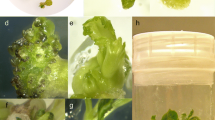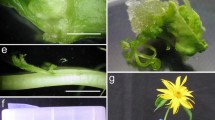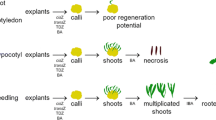Summary
Thirteen soybean genotypes representing maturity groups IV−VI were compared for organogenic responses on three media cultured under two lighting conditions with hypocotyl sections excised from 7-d-old seedlings. All soybean lines responsed by producing adventitious shoots on the acropetal end of the hypocotyl explants, confirming genotype-independence of shoot initiation. Media containing 6-benzyladenine (BA; 5.0–10 μM) induced the greatest numbers of shoots. Histological studies confirmed the adventitious nature of arising shoots by indicative formation of meristematic zones and shoot primordia from parenchymatous tissues of central pith and plumular trace regions of the hypocotyl. Incompletely excised cotyledonary buds also contributed to shoot initiation. Degrees of responses were media-dependent and varied with regard to genotype. Centennial, Epps, and Lyon gave the greatest individual responses. Between cultivars (across all treatments), the regeneration potential (percentage of explants producing meristem-like structures or shoot primordia) 4 wk after initiation ranged from 47 to 75%. Four wk later, regenerative ability (number of shoots produced per responding explant) and regeneration efficiency (number of shoots produced per explant plated) yielded 1.4–7.1 and 1.0–5.0 shoots, respectively. The optimized protocol included initiation on a medium containing 5.0 μM BA for 4 wk, then transfer onto a shoot elongation medium (0.36 μM BA) for 4 wk. For 11 genotypes tested, 66–100% of excised shoots produced roots after 4 wk on media containing 12.5–29.2 μM indole-3-butyric acid. Of 109 regenerants transplanted to soil, 94% survived and no sterility has been observed on those mature enough to flower.
Similar content being viewed by others
References
Amberger, L. A.; Palmer, R. G.; Shoemaker, R. C. Analysis of culture-induced variation in soybean. Crop Sci. 32:1103–1108; 1992.
Bailey, M. A.; Boerma, H. R.; Parrott, W. A. Genotype-specific optimization of plant regeneration from somatic embryos of soybean. Plant Sci. 93:117–120; 1993.
Barwale, U. B.; Kerns, H. R.; Widholm, J. M. Plant regeneration from callus cultures of several soybean genotypes via embryogenesis and organogenesis. Planta 167:473–481; 1986.
Barwale, U. B.; Widholm, J. M. Somaclonal variation in plants regenerated from cultures of soybean. Plant Cell Rep. 6:365–368; 1987.
Chang, H. H.; Chan, M. T.Agrobacterium tumefaciens-mediated transformation of soybean (Glycine max (L.) Merr.) is promoted by the inclusion of potato suspension culture. Bot. Bull. Acad. Sin. (Taipei) 32:171–178; 1991.
Christou, P.; McCabe, D. E.; Swain, W. F., et al. Legume transformation. In: Verma, D. P. S., ed. Control of plant gene expression. Boca Raton, FL: CRC Press, Inc.; 1992:547–564.
Freytag, A. H.; Rao-Arelli, A. P.; Anand, S. C., et al. Somaclonal variation in soybean plants regenerated from tissue culture. Plant Cell Rep. 8:199–202; 1989.
Gamborg, O. L.; Miller, R. A.; Ojima, R. A. Nutrient requirements of suspension culture of soybean root cells. Exp. Cell Res. 50:151–158; 1968.
Graybosch, R. A.; Edge, M. E.; Delannay, X. Somaclonal variation in soybean plants regenerated from the cotyledonary node tissue culture system. Crop Sci. 27:803–806; 1987.
Hawbaker, M. S.; Fehr, W. R.; Mansur, L. M., et al. Genetic variation for quantitative traits in soybean lines derived from tissue culture. Theor. Appl. Genet. 87:49–53; 1993.
Hinchee, M. A.; Conner-Ward, D. V.; Newell, C. A., et al. Production of transgenic soybean plants usingAgrobacterium-mediated DNA transfer. Bio/Technology 6:915–922; 1988.
Kameya, T.; Widholm, J. Plant regeneration from hypocotyl sections ofGlycine species. Plant Sci. Lett. 21:289–294; 1981.
Kimball, S. L.; Bingham, E. T. A. Adventitious bud development of soybean hypocotyl sections in culture. Crop Sci. 13:758–760; 1973.
Lersten, N. R.; Carlson, J. B. Vegetative morphology. In: Wilcox, J. R., ed. Soybeans: improvement, production, and uses. Madison, WI: ASA, Inc., CSSA, Inc., SSSA, Inc.; 1987:49–79.
Mante, S.; Scorza, R.; Cordts, J. A simple, rapid protocol for adventitious shoot development from mature cotyledons ofGlycine max cv Bragg. In Vitro Cell. Dev. Biol. 25P:385–388; 1989.
Murashige, T.; Skoog, F. A revised medium for rapid growth and bioassay with tobacco tissue cultures. Physiol. Plant. 15:473–497; 1962.
Pandey, P.; Bansal, Y. K. Plant regeneration from leaf and hypocotyl explants ofGlycine wightii (W. and A.) Verdc. varlongicauda. Jpn. J. Breed. 42:1–5; 1992.
Parrott, W. A.; Williams, E. G.; Hildebrand, D. F., et al. Effect of genotype on somatic embryogenesis from immature cotyledons of soybean. Plant Cell Tissue Organ Cult. 16:15–21; 1989.
SAS Institute. SAS/STAT user's Guide, version 6, 4th ed. SAS Inst. Cary, NC; 1989.
Stephens, P. A.; Nickell, C. D.; Widholm, J. M. Agronomic evaluation of tissue-culture-derived soybean plants. Theor. Appl. Genet. 82:633–635; 1991.
Widholm, J. M.; Rick, S. Shoot regeneration fromGlycine canescens tissue culture. Plant Cell Rep. 2:19–20; 1983.
Wright, M. S.; Koehler, S. M.; Hinchee, M. A., et al. Plant regeneration by organogenesis inGlycine max. Plant Cell Rep. 5:150–154; 1986.
Wright, M. S.; Ward, D. V.; Hinchee, M. A., et al. Regeneration of soybean (Glycine max L. Merr.) from primary leaf tissue. Plant Cell Rep. 6:83–89; 1987.
Wright, M. S.; Williams, M. H.; Pierson, P. E., et al. Initiation and propagation ofGlycine max L. Merr.: plants from tissue-cultured epicotyls. Plant Cell Tissue Organ Cult. 8:83–90; 1987.
Author information
Authors and Affiliations
Rights and permissions
About this article
Cite this article
Dan, Y., Reichert, N.A. Organogenic regeneration of soybean from hypocotyl explants. In Vitro Cell.Dev.Biol.-Plant 34, 14–21 (1998). https://doi.org/10.1007/BF02823117
Received:
Accepted:
Issue Date:
DOI: https://doi.org/10.1007/BF02823117




